Q: My Noco charger show’s 100% SoC but my batt is dead?
I’ve long known Noco chargers are more sales pitch than substance, & I typically try to avoid negative articles, so consider this as educational article…. (grin) Something needed to be said, because this is a question we get weekly. I cannot and will not recommend a Noco charger for any vessel that has dockside parasitic loads Because Noco chargers DO NOT have a float stage. Sure, Noco makes it sound as if these are the smartest, Einstein level chargers, money can buy. Hint, they’re not! They are nothing more than an ON/OFF chargers with lots of hidden/secretive specs.
I challenge MHT readers to find published docs that explain, in detail, how Noco chargers operate eg:
What is the Absorption Duration for:
Flooded Lead?
AGM?
GEL?
LiFePO4?
What is the re-bulk voltage (target Threshold)?
Specs for temp compensation?
Why Write This Article?
My brother & I had a very expensive set of AGM batteries in our F550 dump/plow truck ruined due to a Noco Genius 3500 charger back a number of years ago. I have spoken with Noco tech support on multiple occasions to identify this mysterious “target threshold”, often referred to as the re-bulk voltage, where the charger starts the bulk stage again. I have spoken with three different Noco TSR’s, and each time I get a very different answer? When I press them for a more detailed technical engineering answer they always revert back to “We don’t share that information it is proprietary info“., Statements like this fire up my BS-Meter. Seeing as Noco would not share this data I set up my logging equipment in the lab and sought to find these answers on my own. The charger I used was a Noco Genius G3500 with a Lithium battery profile. The exact same model that allowed our F-550 AGM’s to discharge to an un-startable level all while displaying 100% SoC.
Test Equipment:
Charger- Noco Genius 3500
Battery – WOXABHSL 7 Ah LiFePo4
Voltage Logging : Fluke 289, EBC-A20
Capacity Testing: WMR-CBA-5Pro
So what affordable chargers do we recommend? Victron!
Please remember this site is 100% supported by you, our readers! Purchasing equipment via our links allows us to make a very small commission but does not cost you any more! Please help keep this site free!
Bottom Line: There is no need to invest in any maintenance/affordable portable charger other than the VICTRON Blue Smart IP 65 OR IP 67’s! You can read all about them at this link:
Choose Your Chargers Carefully!
Links below are to our affiliate partners . Bay Marine Supply is amazing to deal with and they 100% support what they sell.. We have even included an Amazon link for those who don’t care about after-sale support. Affiliate Disclaimer
BUY VICTRON IP65 CHARGERS -BAY MARINE
BUY VICTRON IP67 CHARGERS- BAY MARINE
The Testing:
Testing especially like this, takes lots of time. To cut down on the process we used a small 7Ah LiFePO4 battery I use for our remote security cameras on the homestead. The complaint we keep getting is; the reader gets to their boat to find the charger suggesting the bank is at 100% SoC. They hoist sails, get under way and a few minutes later the vessel loses all power.
How can this happen if the battery was at 100% SoC?
Most every cruising boat, or any boat over about 25′, has some level of parasitic/quiescent load on the battery when the vessel is not in use. Remember when I mentioned Noco chargers are ON/OFF chargers?
What I mean by that is a Noco charger does not have a float stage after absorption like any quality deep-cycle marine battery charger. A quality charger, eg: Victron, Pro Mariner Pronautic P, Sterling Power Pro-Charge Ultra, Blue Sea, Mastervolt, Xantrex etc. will charge the battery to the targeted absorption voltage, run an absorption cycle, calculated numerous different ways, then drop to a float/maintenance voltage of 13.2-13.6V+/-. The float voltage keeps the batteries at 100% SoC ready to use and fends off sulfation in lead acid batts.
Sadly, Noco chargers don’t do this, they charge to absorption voltage then Shut off completely and allow battery voltage to decay to the mysterious, unpublished “voltage target threshold” before turning back on. In the case of this LiFePO4 battery, the “Genius” allowed the battery to discharge all the way to 12.53V before turning back on. After a “parasitic load discharge” this battery is at roughly 8.8% SoC! Not what you would expect from a “Genuis” telling you the battery is 100% charged. D’oh….
Here’s how it behaves:
In order to repeat what our readers are complaining about we applied a 0.5A quiescent load once the charger turned off. I missed the exact point at which it shut off while getting the logger fired up. The logger caught it at 13.65V as the .5A load was applied and voltage dropped the peak voltage I saw was 14.2V. The charger is 3.5A so the 0.5A load still left 3A of charging for when it decided to re-start on this log. When the charger reboots voltage climbs, it then shuts off again and resumes a few seconds later.. I surmise this is the charger making sure the battery is safe to charge.? However with all the secretive unpublished specs one can only guess as Noco considers this “proprietary” info..
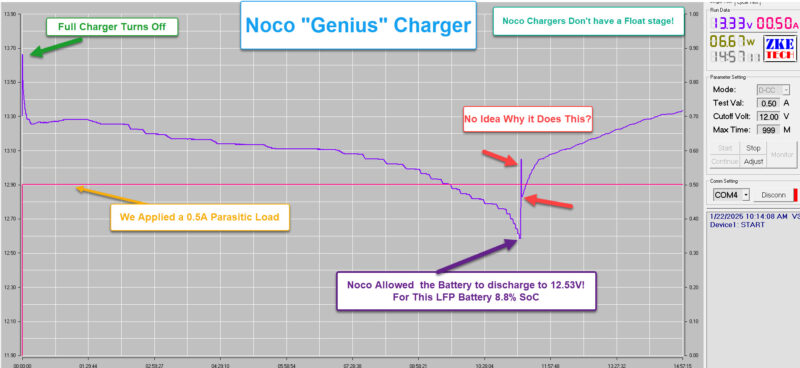
I was also able to grab this pic just before the charger turned back on…
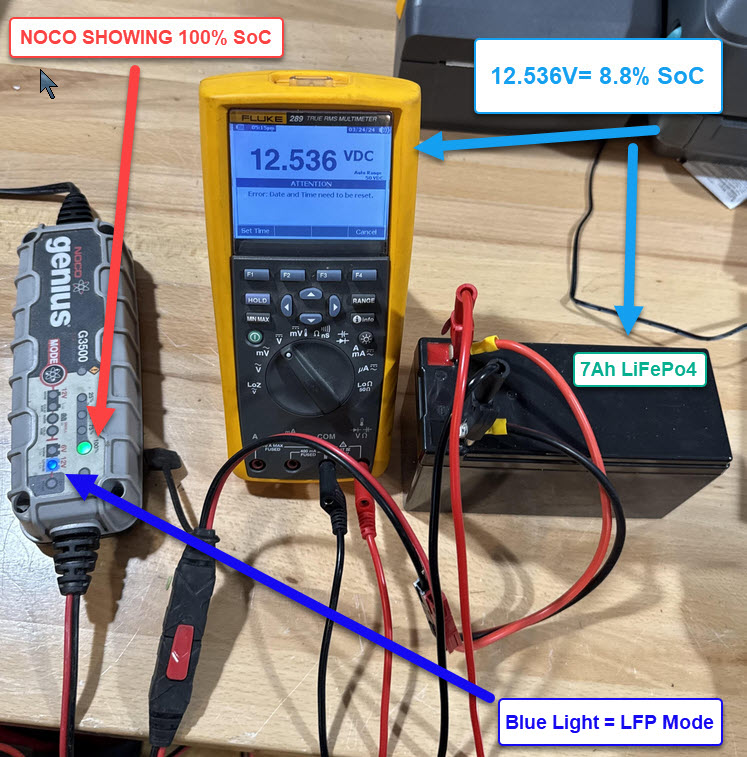
A few seconds after I published this article a keyboard warrior posted this:
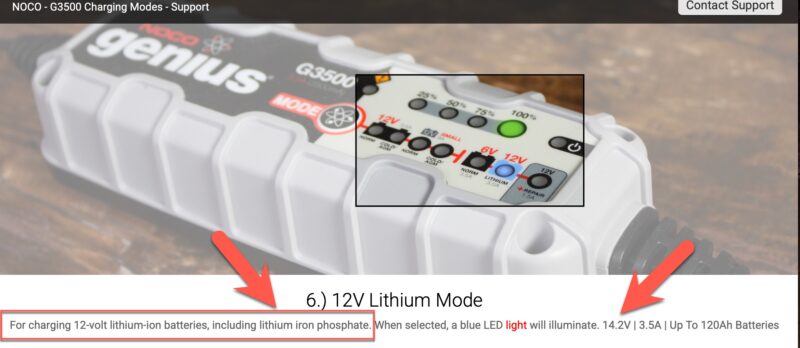
If the keyboard warrior had actually done any research he would know that when this charger is set to AGM the absorption voltage is 14.8V and the max voltage for any LFP battery is 3.65V per cell or 14.6V. Noco clearly specifies LiFePo4 and 14.2V is enough to fully charge an LFP battery.
Why quiescent loads discharge your batteries lower than published data would suggest?
A quiescent/parasitic load is so small an LFP battery will be at near 10% SoC or lower by the time batt voltage gets to 12.53V. If the load is small enough your batt could be at 0%..
To illustrate this we were forced to run multiple discharge capacity tests one at 3.5A/.5C (industry standard discharge rate for LFP) and one discharge at 0.5A/.07C , which is the parasitic load we chose for this test to re-create reader complaints. Sure, we could have used 0.1A and likely wound up at closer to 0% but 0.5C & 0 .07C illustrate the point that parasitic discharges can suck an LFP nearly dry before a Noco will turn back on and re-charge it..Note: This 7Ah battery is in perfect health delivering over 7Ah..
Here’s the .5C discharge:
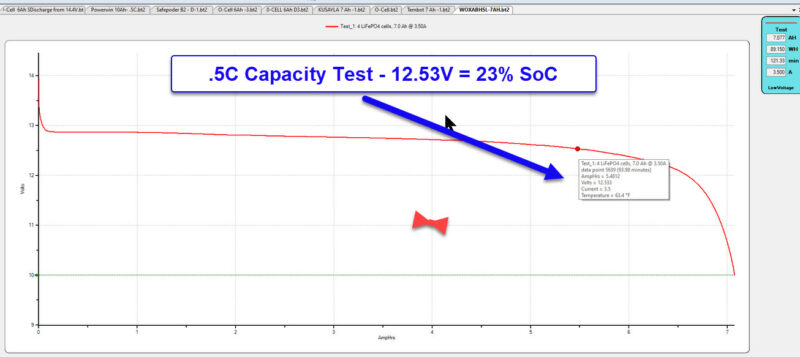
Here’s the Same graph at 0.5A /.07C
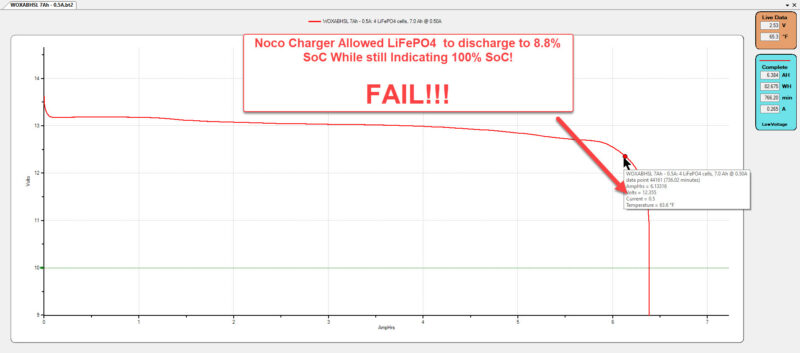
Why Does Noco even make chargers like this?
The answer may surprise you, California!
Understanding California’s Energy Rule for Battery Chargers:
The California Energy Commission (CEC) has implemented a rule that requires battery chargers to turn off or reduce power usage significantly once the device they are charging is fully charged. This rule is part of California’s efforts to save energy, lower electricity bills, and reduce environmental impact.
Why Does This Rule Exist?
California’s Take:
- Energy Waste is a Problem: Many battery chargers, like those for phones, laptops, or power tools, continue to use electricity even after the battery is fully charged. This is called “vampire power” or “standby power,” and it adds up over time. If millions of chargers across California are wasting energy like this, it creates a significant problem.
- Environmental Impact: Wasting electricity means more energy needs to be produced, often by burning fossil fuels. This leads to higher carbon emissions, which contribute to climate change. By cutting down on wasted energy, the rule helps reduce pollution.
- Saving Money: When chargers stop drawing unnecessary power, it reduces electricity usage. Over time, this can lower your utility bills, especially if you have multiple devices that need charging.
What Does the Rule Require?
The rule applies to most consumer battery chargers sold or used in California. Here’s what it mandates:
- Automatic Shutoff: Battery chargers must automatically stop drawing power from the wall when the battery is fully charged. For example, if you plug in your phone overnight, the charger should stop using electricity once the battery reaches 100%.
- Energy Efficiency Standards: Chargers must meet specific efficiency requirements. This means they should use minimal power while actively charging and even less power when the device is fully charged or not connected.
- Testing and Compliance: Manufacturers need to test their chargers to ensure they meet these standards. Products that don’t comply can’t be sold in California.
What Types of Chargers Are Covered?
The rule applies to a wide range of chargers, including:
- Small Electronic Devices: Chargers for phones, tablets, smartwatches, and other small gadgets.
- Larger Devices: Chargers for laptops, cameras, and similar equipment.
- Specialized Equipment: Chargers for power tools, electric scooters, and other battery-powered devices.
However, there are some exceptions. For example, industrial or medical equipment chargers might not fall under these rules.
The problem lies with how you implement these energy saving features. Noco chooses to turn off and not re-start until 12.53V (for this particular “Genius”). In other-words, this charger will not only cycle your battery needlessly but, for leads acid, can result in sulfation and more ruined batteries in the land fill. Not what California intended, I’m sure…. I also suppose California did not intend to burn LA by refusing to properly manage forests to mitigate fire danger…? (grin)
Other charge manufacturer’s such as Victron, Mastervolt Pro Mariner, Sterling Xantrex etc. all give you options to program your own settings. The rule only mandates the charger being sold complies. In the case of Victron, they allow full custom programming. California rules do not prevent you from buying a quality programmable charger and create your own custom profile to escape California’s lunacy.. As an example a Victron IP65 5A charger, that is fully custom programmable, with their free BT app, is only $85.00 with Victron’s amazing 5 year warranty. A Noco 5A is $79.95, will not maintain your batt at 100%, is not programable, and only has a three year warranty.
Hope this helps those of you who bought Noco’s only to find your LFP batts at very low SoC..
Like What You Saw Or Read?
Would you like to see more articles like this? Is so feel free to donate, support the site and keep it growing.
Please DO NOT feel obligated at all. If you like it and want to make a small donation than that’s all I ask.
Your donations help keep the content coming and also help keep it free.
Click the DONATE button below if you would like to make a donation via PayPal.



